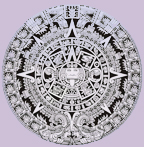Mayanism blends spirituality from Mexico (MesoAmerican) with teachings from the Plains natives of North America, shamanism, New Age ideas, and Wicca. An eclectic way of following the Red Road, the path of walking with Spirit, Mayanism is practiced slightly differently by all who embrace it.
My path to Mayanism led from the 260-day MesoAmerican calendar, and that calendar (called the Tzolkin or the Tonalpoualli) remains the centerpiece of my practice. I live according to that sacred calendar as a Daykeeper, and follow its energies. I have many friends on this road, and some don’t follow or use the calendar energies at all, while others are Daykeepers like me.
The Tzolkin consists of 20 day-signs, repeated in an endless loop (much like we have Monday, Tuesday, Wednesday), matched with the numbers one through thirteen. It takes 260 days, about nine months, to cycle through all permutations. Each day-sign has its own energy, which is modified by the number. For instance, we recently passed 7-Ahau/Xochitl on the calendar. That day’s energy consists of the Lord energies of Ahau (the Mayan version of the day-sign) and the Flower energies of Xochitl (the Aztec version of the day-sign), which together represent the pinnacles we strive for, and the number seven, which is perfect balance and magic. 7-Ahau/Xochitl is also an incoming portal day, which means we receive energies from the gods (karmic rewards, manifestations, healings, etc.).
Studying the calendar’s day-sign meanings led me into the spiritual practices of the pre-Columbian MesoAmericans. Since I was already a pagan, it seemed natural for me to incorporate some of the deities and practices into my own ceremonies. I had no idea that anyone else had done anything like it, and after a few years of being solitary on that path, I met other Meso-American enthusiasts online and trained with some of them, which has deepened my appreciation of the Maya and Aztec people as they were before Cortes came to Mexico (which they called Cem-Anahauc, the One World).
My ceremonies now have only the most basic relationship to Wicca—I cast a circle and call quarters, but I use the day-signs and deities of Mexico. The stories I illustrate in ritual are not European, Norse or Celtic like my Wiccan friends use; they are based on MesoAmerican mythology. At Samhain (Halloween), I take my people on a journey into Mictlan, the underworld, and then we are reborn. At the winter solstice, we celebrate a version of the New Fire Ceremony (which the Aztec held every 52 years). At Imbolc (Candlemas), we meet the night sun jaguar. In every ceremony we also honor the Mayan Tree of Life. I was always attracted to dragons and dragon magic; now I call to the Feathered Serpent, Quetzalcoatl/Kukulkan, the dragon of the New World, instead of the dragons of Europe or China. I am grateful to be able to conduct these rituals at Curious Goods in West Haven, where they are presented alongside more traditional Wiccan and pagan ceremonies. I have several Reiki masterships, and it seemed divinely inspired when I discovered Mayan Reiki, which blends the energies of the Mayan calendar and pantheon with the traditional Reiki energies. This enables me to use the day-signs in a whole new way, for healing. I already use them for divination, astrology and in ritual.
On my own, I studied the calendar and used it for divination and astrology for over ten years before incorporating the energies into ritual. That is the road my tonalli (my fate) led me down—others I have befriended have jumped right into it. Since I have met others who do this work, my own path has accelerated as we blend our energies and knowledge, and more doors to further learning have also opened to me.
I believe more people will join us on this Red Road. As the society we live in becomes increasingly mechanized and impersonal, everyone is seeking connection—to other people, and to the earth. Some look to their ancestors and study the religions of the Old World--Europe, England, the Celts, the Norse. Some, like me, look at the ancient practices of the place where they live right now—the New World. The calendar of the Aztecs and Maya (also of the Toltecs and Olmecs, among others) offers many opportunities to work with some unique energy concepts and archetypes—it can be used for divination, astrology, ritual and daykeeping. The Popul Vuh, a sacred book of ancient legends, provides fodder for rituals and guided meditations. MesoAmericans worshipped hundreds of gods and goddesses, each of which has many different aspects. My personal favorites are Itzpapalotl (Obsidian Butterfly), Tlazolteotl (Filth Eater), Quetzalcoatl/Kukulkan (Feathered Serpent), and Hunab Ku (Giver of Movement and Measure). Researching the various deities and their associated rituals and symbols can be a ceremony itself.
I also enjoy the concept of feeding the deities and giving them gifts. These gifts are known as itza, or sacred essence. Itza can be candle wax, incense smoke (especially copal), flowers, herbs, food, tobacco, crystals, or even your sweat. These offerings can be burned, buried or given to the water.
Mayanism is not an exact science. It’s a form of spirituality. I don’t know if anyone could ever follow a spiritual path 100% exactly if one was not born into that culture and timeframe. But we can honor the path, and follow it to the best of our abilities, even if the culture of our birth does not match. I spoke recently with Maestro Tlakaelel, a master teacher and Aztec Elder, about his feelings for those without Native blood studying Native traditions. He told me that to follow the Red Road means to leave prejudice (in all forms) behind.
I hope that you will choose to walk with me someday.
This article first appeared in print in the fall 2005 "Earth Religions" issue of The Door Opener and later in the Summer Solstice 2006 issue of the Lunar Quarterly
, the Astrological Society of Connecticut's quarterly print magazine for members.

